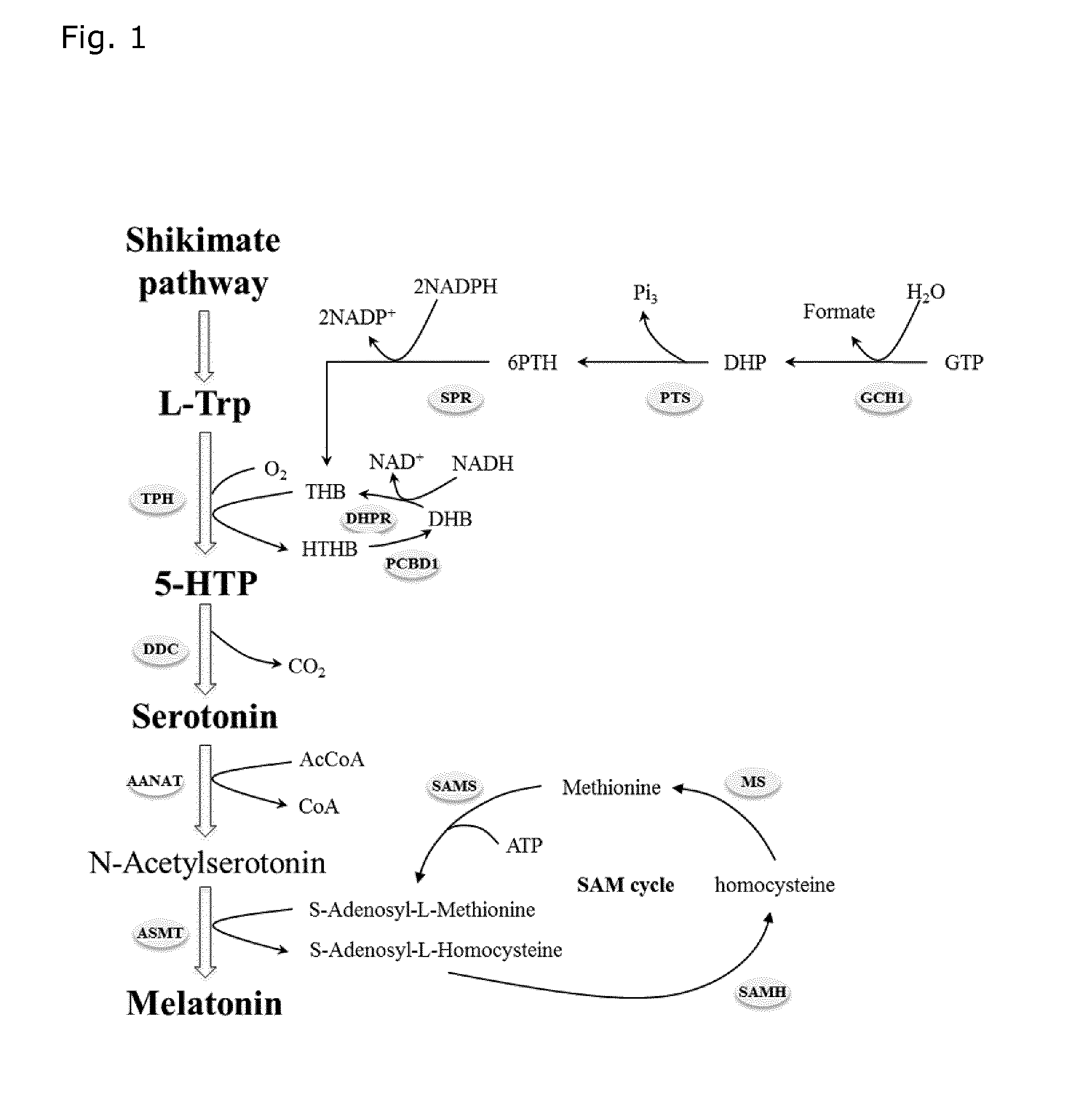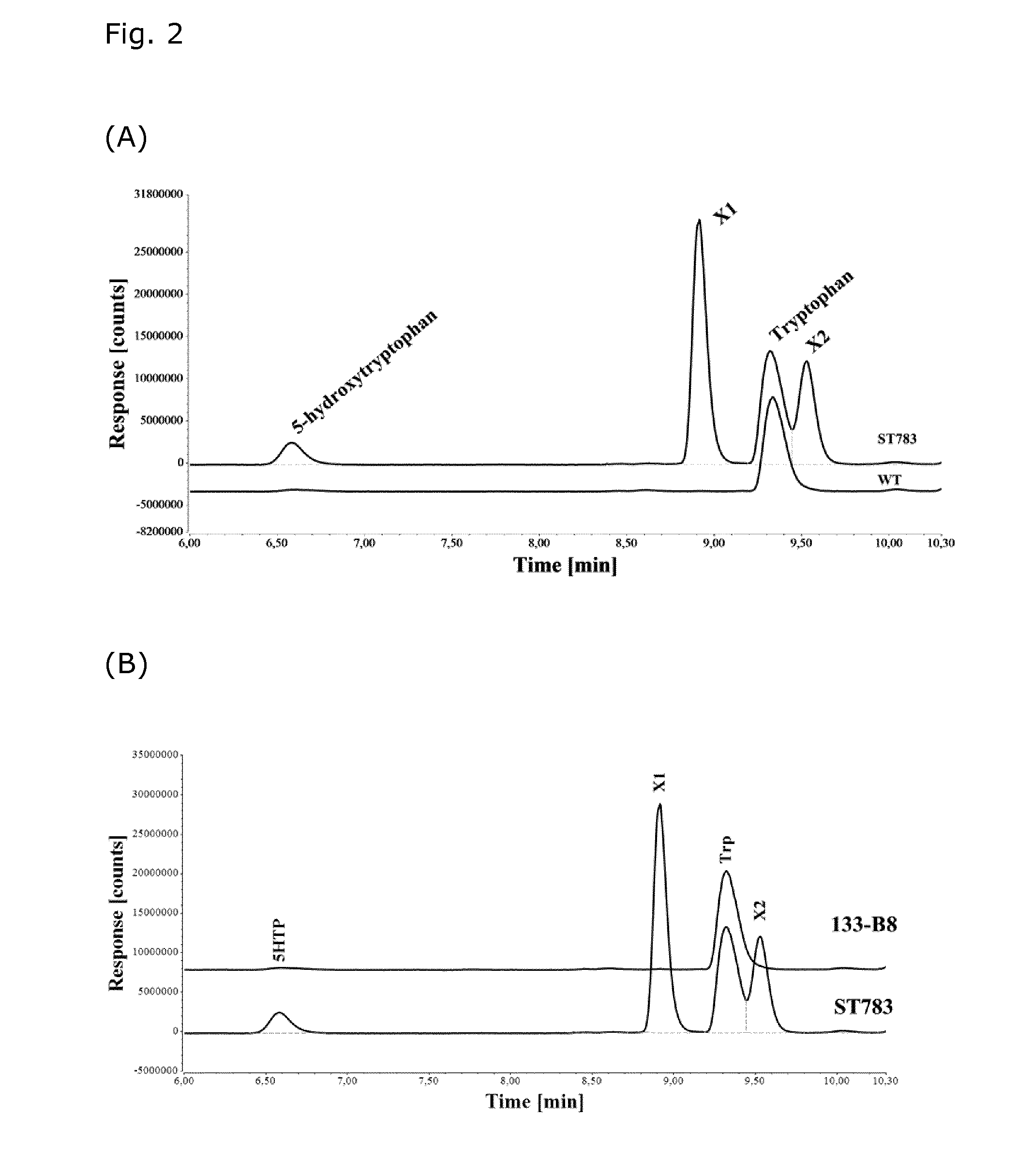Microorganisms for efficient production of melatonin and related compounds
a technology of melatonin and microorganisms, which is applied in the direction of lyase, transferase, bulk chemical production, etc., can solve the problems of low yield and high extraction cost of extraction process
- Summary
- Abstract
- Description
- Claims
- Application Information
AI Technical Summary
Benefits of technology
Problems solved by technology
Method used
Image
Examples
example 1
[0171]This Example describes the reconstruction of exogenous pathways for 5HTP or melatonin production in Saccharomyces cerevisiae.
[0172]Laboratory S. cerevisiae strain CEN.PK113-7D (MATa URA3 HIS3 LEU2 TRP1 MAL2-8C SUC2) was used as reference strain, and the S. cerevisiae strain CEN.PK102-5B (MATa ura3-52 his3Δ1 leu2-3 / 112 TRP1 MAL2-8C SUC2) was used for strain construction.
[0173]Genes encoding a TPH, the THB synthesis pathway including a PTS and an SPR, and the THB recycling pathway including a PCBD1 and a DHPR, were synthesized and incorporated into integration plasmids pX-3-KILEU2, pXII-5-SpHIS5 / pX-4-SpHIS5, and pXI-3-KIURA3, respectively, using the method developed by Mikkelsen et al. (2012). The primers used for the cloning are listed in Table 2. The TPH, PTS, SPR, PCBD1, DHPR genes were all expressed under strong promoters, TEF1, PGK1, PGK1, TEF1, and TEF1, respectively. The constructed insertion plasmids were transformed into a S. cerevisiae CEN.PK102-5B strain following th...
example 2
[0185]This Example describes the reconstruction of exogenous pathways for 5HTP and melatonin production in Escherichia coli.
[0186]Genes encoding a TPH, the THB synthesis pathway including a GCH1, a PTS and an SPR, and the THB regeneration pathway including a PCBD1 and a DHPR were synthesized and incorporated into two compatible plasmids. The genes encoding TPH, PCBD1, and DHPR were organized as one operon (TDP operon; SEQ ID NO:146) and incorporated on the pUC18 to derive the pTDP plasmid. The genes were expressed under a lac promoter. The genes encoding GCH1, PTS, and SPR were organized as one operon (GPS operon; SEQ ID NO:147) and incorporated on the pTH19cr for the construction of the pTHB plasmid. The genes on GPS operon were expressed under a lac promoter. The plasmids were constructed using a DNA assembling method (Gibson et al., 2009).
[0187]The wild type E. coli MG1655 strain can degrade 5HTP into 5-hydroxyindole. The enzyme catalysing this reaction in E. coli is tryptophana...
example 3
[0190]This Example describes improving the production of melatonin in S. cerevisiae by enriching AcCoA in the cell.
[0191]Acetyl coenzyme A (AcCoA) serves as a metabolic cofactor in the serotonin acetyltransferase reaction. The conversion of serotonin into N-acetylserotonin was not complete in the previously constructed strains (see FIG. 3 and FIG. 4). Engineering the AcCoA metabolism can thereby improve the supply of the precursor for the reaction. A higher AcCoA / CoA ratio changes the thermodynamic equilibrium of the reaction, making it more favorable towards N-Acetetylserotonin generation. Feeding carbon sources such as glucose during the culture improves AcCoA availability in the cell, but there are many competing pathways using AcCoA as a substrate. It has been shown, however, that engineering the metabolic pathways can better improve the supply of AcCoA (Kocharin et al., 2012). Therefore, the following pathway modification approach was designed to facilitate the ASMT reaction:
[0...
PUM
| Property | Measurement | Unit |
|---|---|---|
| temperature | aaaaa | aaaaa |
| pH | aaaaa | aaaaa |
| flow rate | aaaaa | aaaaa |
Abstract
Description
Claims
Application Information
 Login to View More
Login to View More - R&D
- Intellectual Property
- Life Sciences
- Materials
- Tech Scout
- Unparalleled Data Quality
- Higher Quality Content
- 60% Fewer Hallucinations
Browse by: Latest US Patents, China's latest patents, Technical Efficacy Thesaurus, Application Domain, Technology Topic, Popular Technical Reports.
© 2025 PatSnap. All rights reserved.Legal|Privacy policy|Modern Slavery Act Transparency Statement|Sitemap|About US| Contact US: help@patsnap.com



